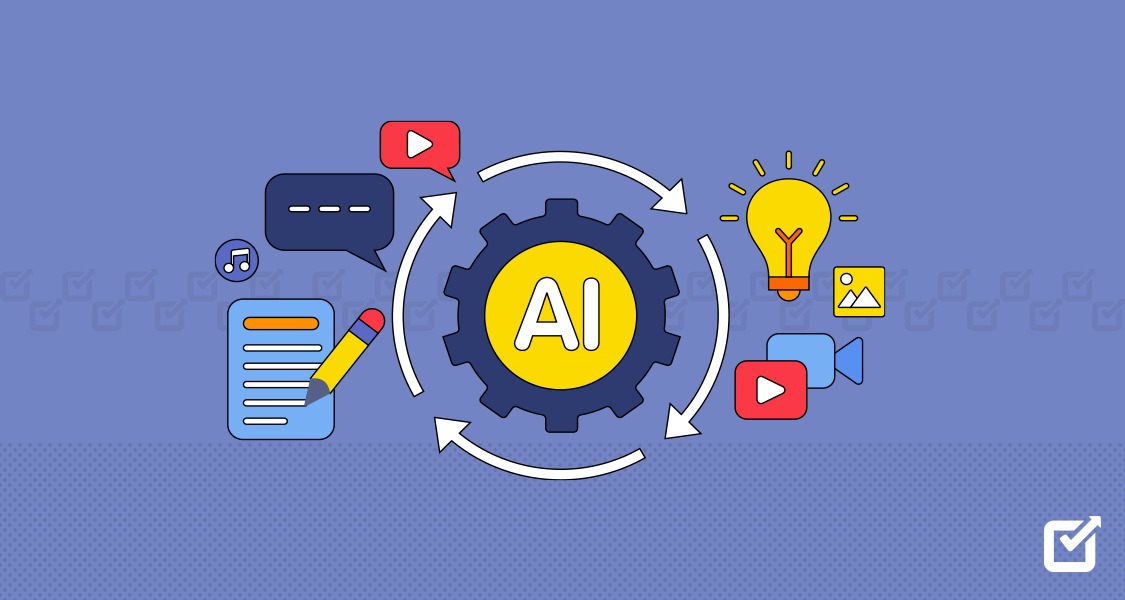Creating great content used to be a time-consuming task.
After all, you have to draft posts, design visuals, edit videos, and manage ten plus platforms simultaneously.
But now, AI content creation tools are making it easy!
You no longer need a huge team to produce high-quality content at scale; AI is filling in the gaps with speed, accuracy, and surprising creativity.
In fact, 67% of marketing professionals use generative AI for content creation, with 70% using AI tools weekly.
These tools are not just designed to save time, but also to help you stay competitive in a world where both speed and quality matter.
But with so many tools flooding the market, the real question is: Which ones are actually worth using?
In this blog, we’ve handpicked the best AI tools for content creation that deliver, from writing assistants and design tools to effective social media tools.
Let’s get into it.
CTA
Is Your Content Strategy Future-Ready?
Social Champ’s AI-powered tools handle posting, repurposing, and analytics so you can focus on what matters—growing your brand.
Short Summary
- AI content creation tools, such as ChatGPT and Jasper, have become increasingly vital for producing blogs, social media posts, and SEO-rich content.
- Tools such as ChatGPT, Jasper, Copy.ai, Wordtune, Simplified AI, and Surfer SEO help generate, optimize, and refine content for various formats and audiences.
- Image generation tools like Midjourney, Leonardo AI, DALL·E 3, and Adobe Firefly accelerate creative workflows by producing visuals that complement written content.
- Platforms like Social Champ use AI to automate post creation and scheduling.
- The best AI content creation tool depends on content type, team size, integration needs, and budget to ensure the AI tool fits your workflow and goals.
What Are AI Content Creation Tools (And Why They’re Essential in 2025)
AI content creation tools are software powered by artificial intelligence that assist or automate the process of creating digital content—think blog posts, social media captions, videos, images, emails, and even podcasts.
These tools utilize machine learning and natural language processing to comprehend prompts, generate human-like text, design visuals, edit videos, and repurpose content across various platforms.
Today, they’ve become essential for staying competitive.
Here’s why: content demand has exploded, but teams haven’t grown at the same pace. Brands need to be everywhere, all the time—on blogs, Instagram, LinkedIn, YouTube, TikTok.
That means producing more content in less time, without sacrificing quality.
AI tools help bridge that gap. They accelerate research, spark new ideas, ensure consistency, and automate repetitive tasks, allowing creators to focus on strategy and storytelling.
Instead of spending hours brainstorming or editing, you get more done in less time and with way less stress.
It’s how today’s creators, marketers, and businesses are staying ahead without burning out.
Featured Article: SaaS Social Media Marketing: 20 Proven Strategies to Drive Growth in 2025
Top AI Content Creation Tools for Writing, Copy, and SEO
Over the past year, we’ve tested a range of AI writing tools, some impressive, others not quite ready for prime time.
But a few have consistently stood out for their ability to deliver clean, on-brand, and SEO-friendly content with minimal friction.
These tools streamline everything from ideation and outlining to optimization and editing.
If you’re creating blog content, ad copy, landing pages, or anything SEO-rich, these are the tools we keep coming back to.
-
ChatGPT
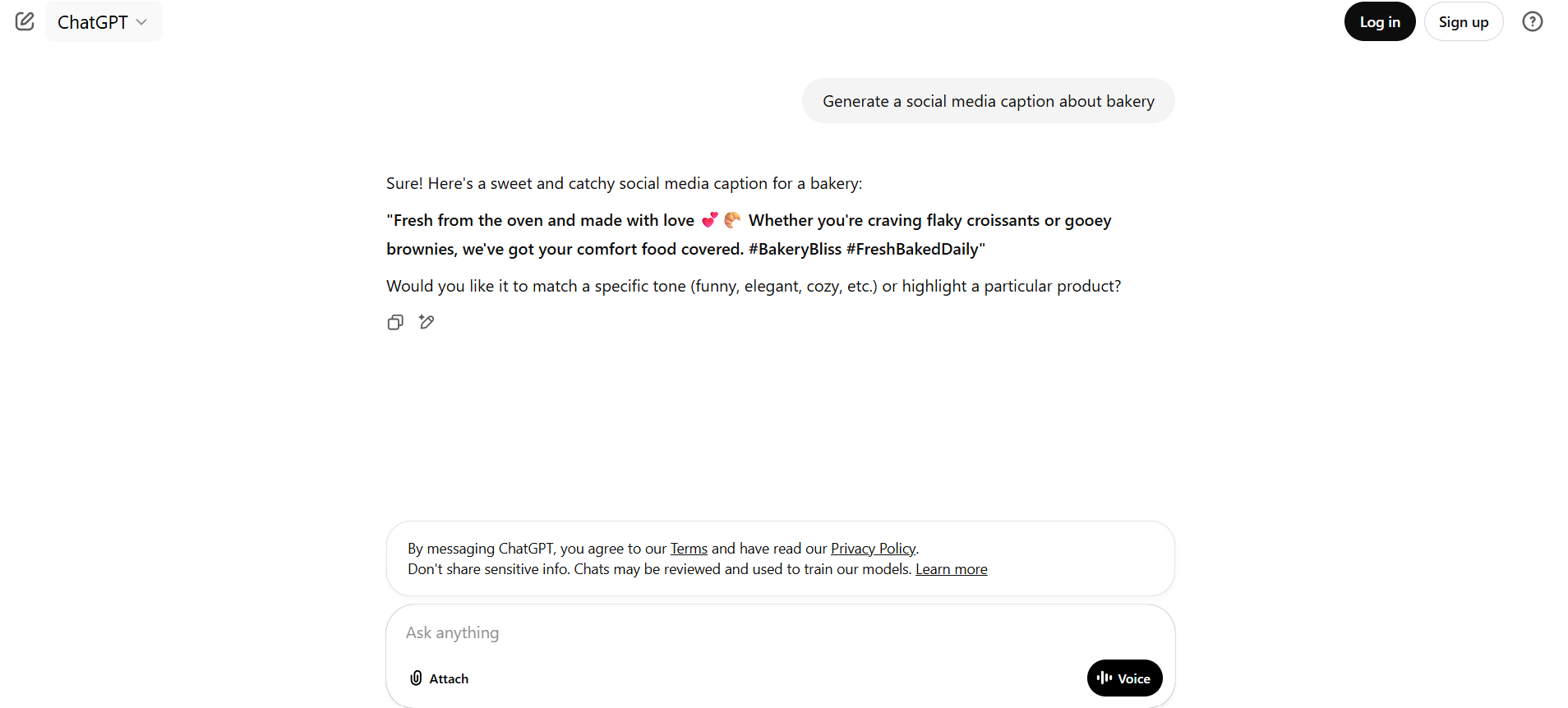
ChatGPT’s Dashboard In our top picks for free AI tools for content creation, ChatGPT operates on a conversational model where you input prompts or questions, and it generates responses accordingly.
For content creation, this means you can draft articles, brainstorm topics, or create outlines by giving clear instructions.
It can produce long-form, coherent content that flows naturally, predominantly when guided step-by-step through prompts.
You can ask it to rewrite, summarize, or expand text, making it a flexible assistant throughout the writing process.
However, because it generates content based on patterns in the data it was trained on, you’ll need to fact-check and adjust for accuracy and style.
-
Jasper
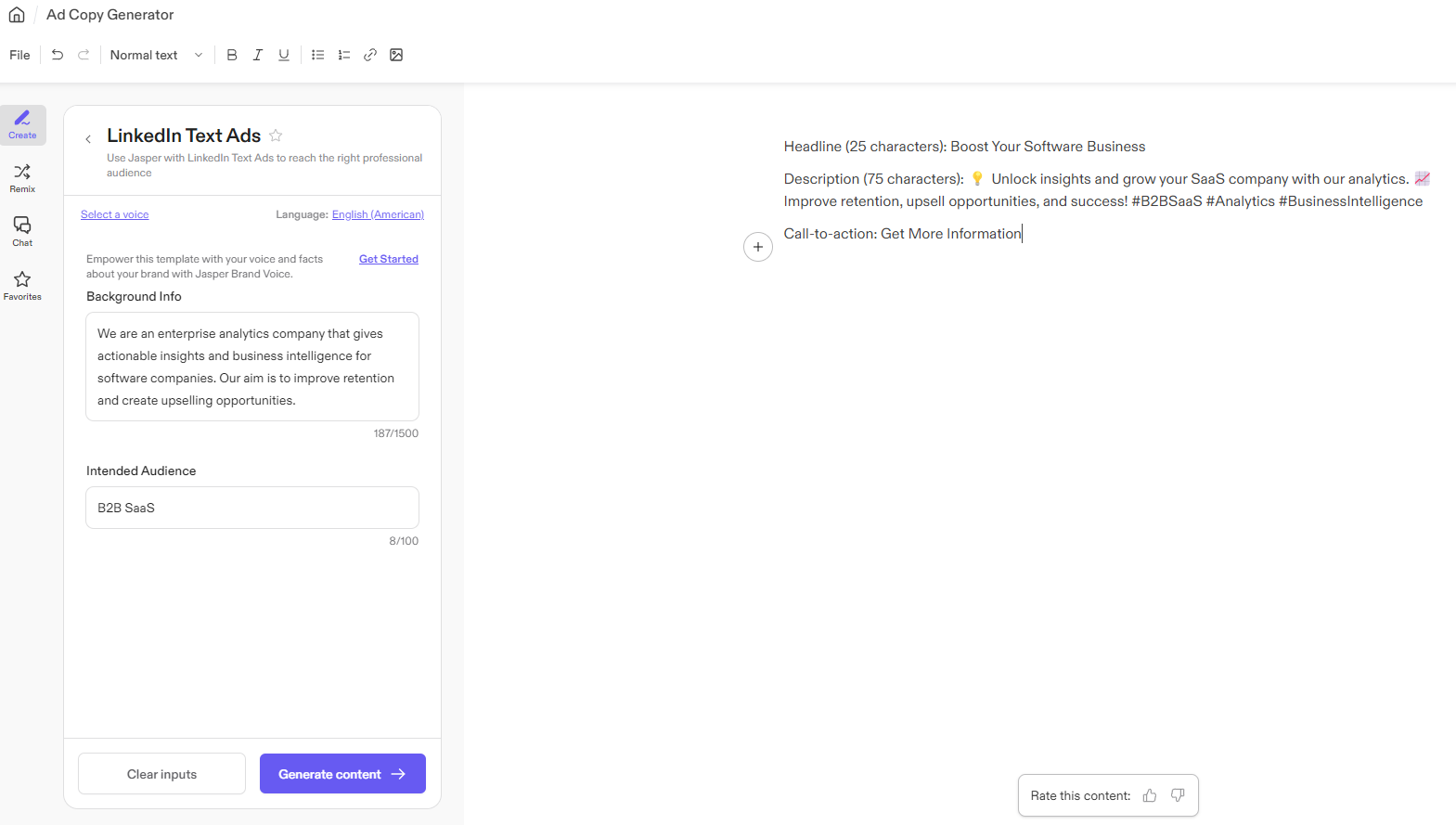
Jasper AI’s Dashboard Jasper is structured around templates designed for marketing and SEO-friendly content.
You start by selecting a template like blog introductions, product descriptions, or email copy, and input relevant details about your topic or brand.
Jasper then generates text that fits the template’s purpose.
It’s “Boss Mode” allows for longer-form writing where you provide more detailed instructions, and it continues generating text beyond simple snippets.
Jasper also supports custom brand voice settings, which are particularly useful if you want consistency across multiple pieces or clients.
It integrates with SEO tools like Surfer SEO, allowing you to generate and optimize content simultaneously.
-
Copy.ai
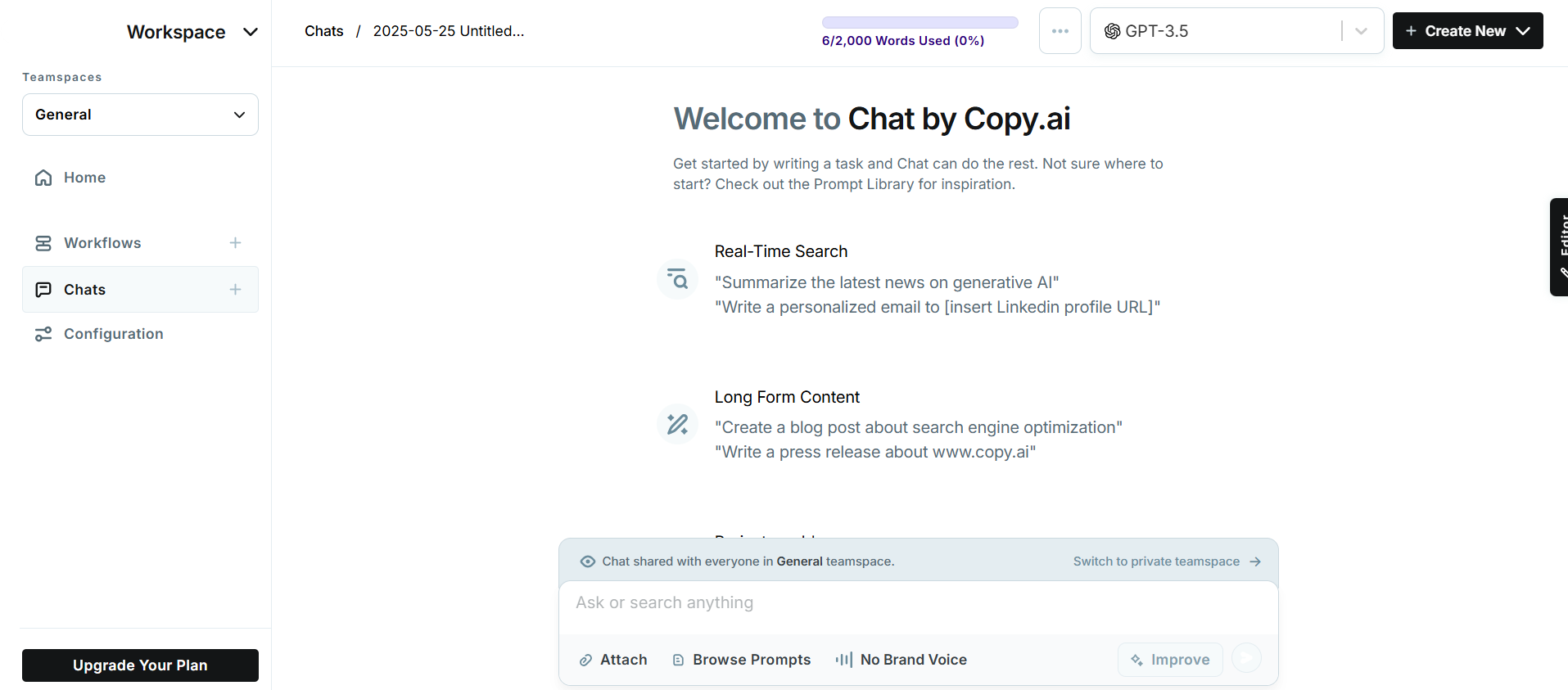
Copy.ai’s Dashboard Copy.ai excels at short-form content creation through a large library of templates.
Whether you need catchy headlines, social media captions, or quick product descriptions, you provide the basic inputs, and the tool generates several variations.
It’s designed for speed and creativity in short bursts of copy rather than long articles.
The interface guides you through selecting a use case; then you tweak the outputs as needed.
It’s particularly helpful when you want to test multiple messaging options quickly or need inspiration for concise, engaging text.
-
Wordtune
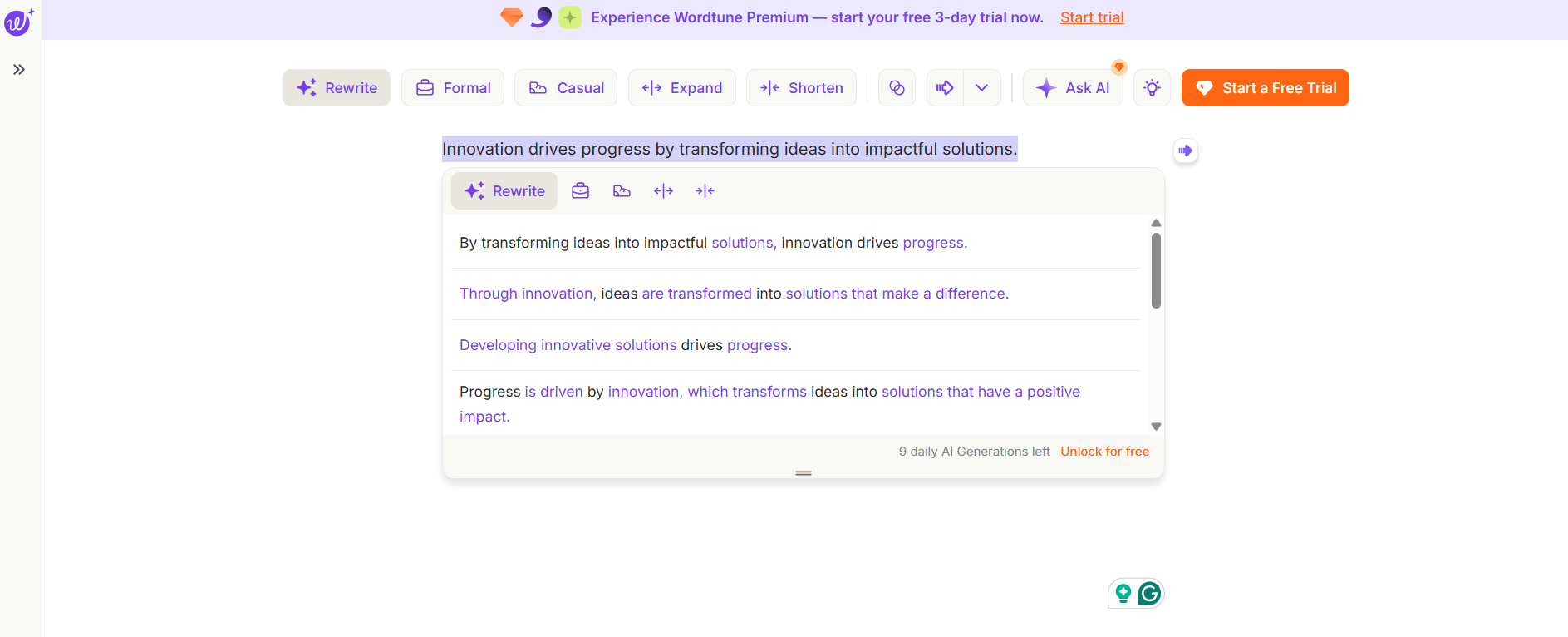
Wordtune’s Dashboard Wordtune is another one of the widely used free AI tools for content creation, rewriting, and refinement, rather than a content generator.
After writing a draft, you paste your text into Wordtune, and it offers alternate phrases for sentences or paragraphs.
You can toggle between different tones —formal, casual, concise —and select suggestions that improve clarity, flow, or emphasis.
It’s especially helpful for polishing content that’s already drafted or adapting copy for different audiences without requiring a complete rewrite from scratch.
It doesn’t generate new ideas but focuses on improving existing ones.
-
Simplified AI
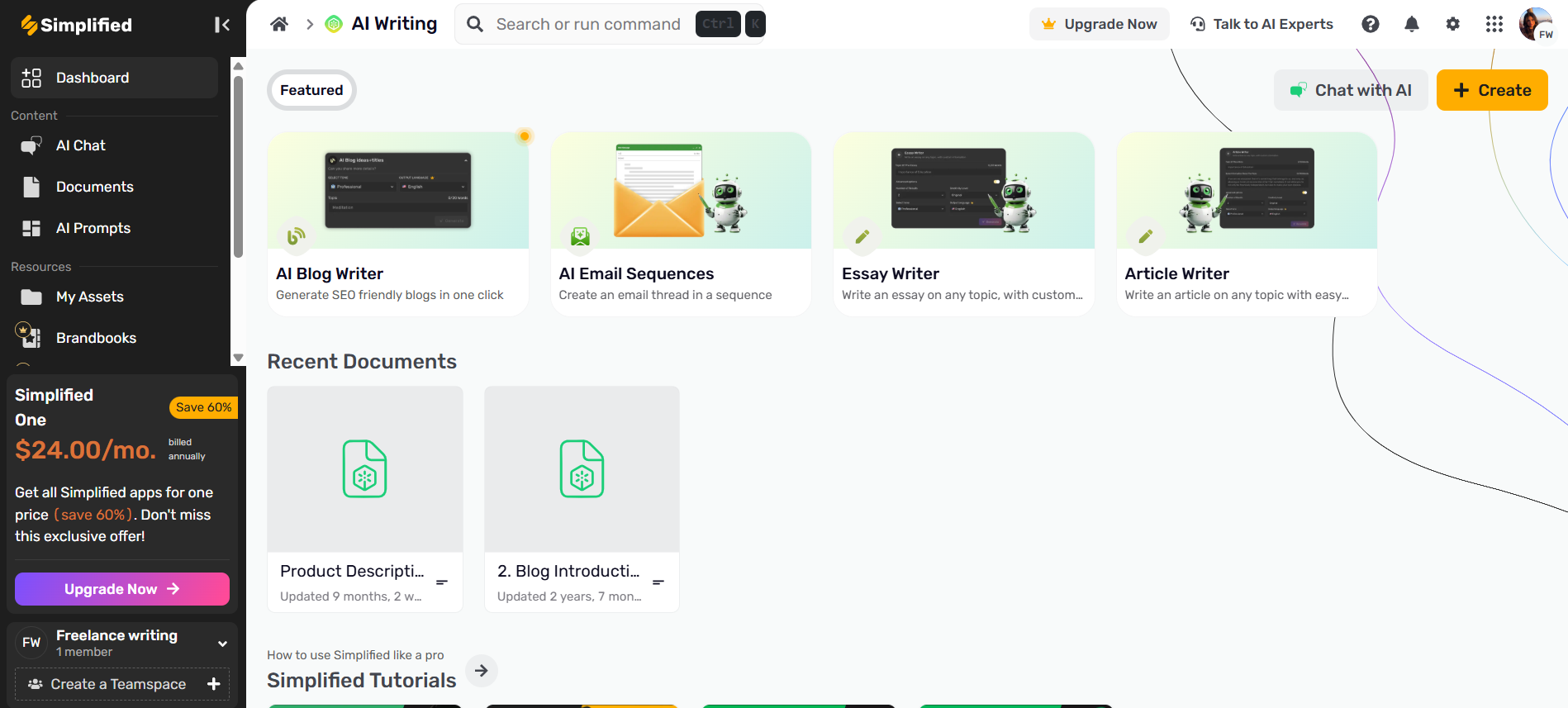
Simplified AI’s Dashboard Simplified AI combines prompt-based writing with automation features designed for quick content generation.
It’s useful for drafting blog posts, social media captions, and basic web copy when speed is important.
You enter your topic or keywords, and the tool produces straightforward text that covers the basics.
It includes some SEO keyword integration but doesn’t offer deep content analysis or optimization.
The focus is on helping content creators maintain a high output volume with reasonable quality, rather than providing detailed customization.
-
SurferSEO Content Editor
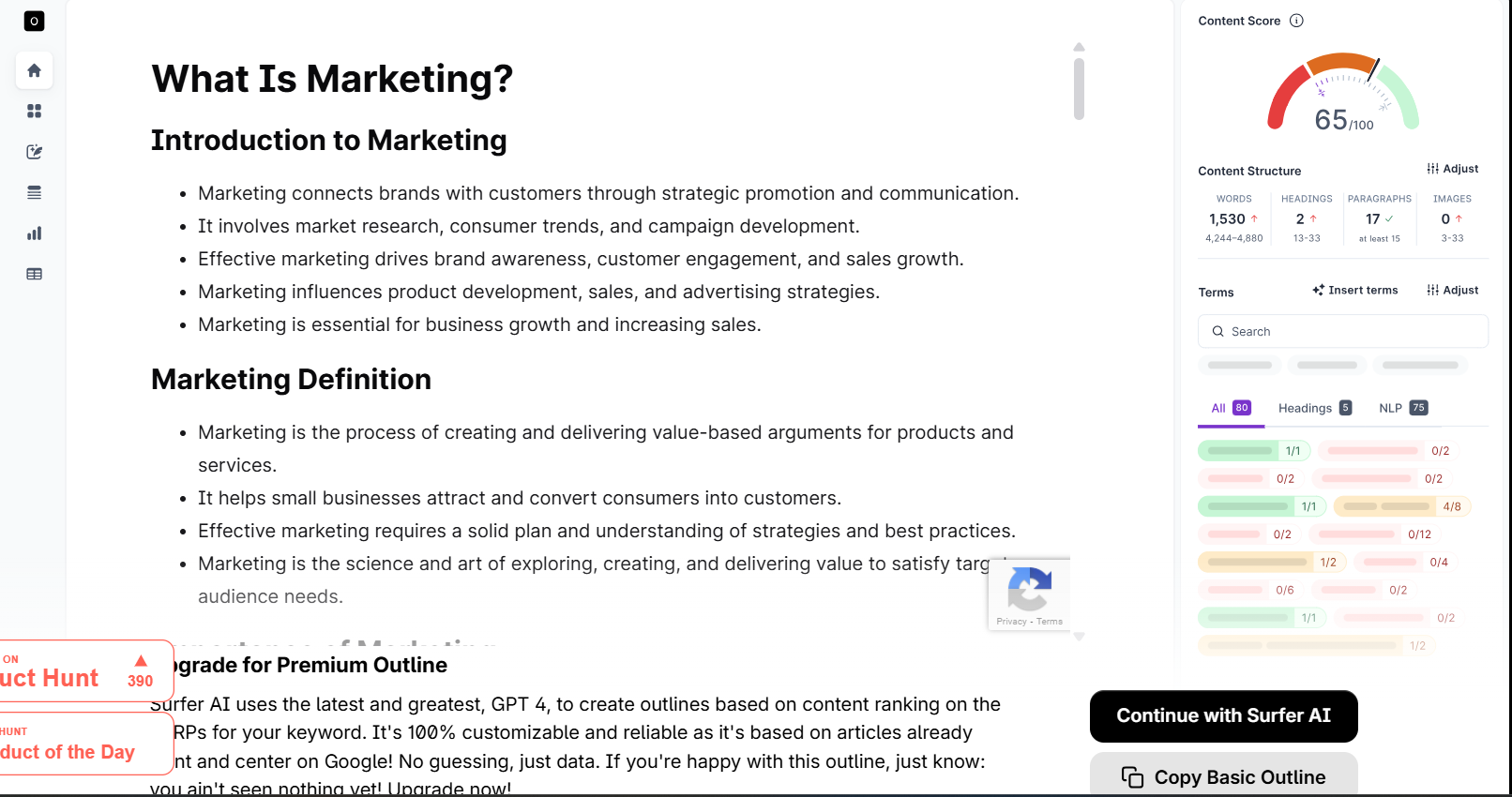
Surfer SEO’s Dashboard SurferSEO functions primarily as an SEO audit and optimization tool.
You start by importing or drafting content within its editor.
It then analyzes your text against top-ranking pages for your chosen keywords, providing detailed suggestions on keyword density, heading structure, content length, and related terms to include.
These recommendations help align your content with search engine algorithms.
It offers real-time scoring and actionable tips, which you can apply directly in the editor.
SurferSEO doesn’t write content itself, but it is typically used alongside writing tools like Jasper or ChatGPT to ensure that SEO best practices are met.
Featured Article: How to Market Your Business on Social Media: 15+ Proven Strategies for Explosive Growth
AI Design & Visual Tools That Supercharge Creative Production
AI-powered design and visual tools are transforming creative workflows by automating complex tasks and enabling faster, more flexible content production.
Whether generating images, editing videos, or building brand assets, these tools help professionals scale their output while maintaining quality.
Below, we’ve outlined some of the top AI solutions in image generation, video editing, and branding tools that we’ve tested, which significantly improve productivity in real-world creative projects.
Top AI Tools for Image Generation
AI image generation tools create visuals from text prompts or guided inputs, removing traditional design bottlenecks.
They let you quickly produce unique artwork, marketing graphics, or concept visuals without starting from scratch.
-
Midjourney
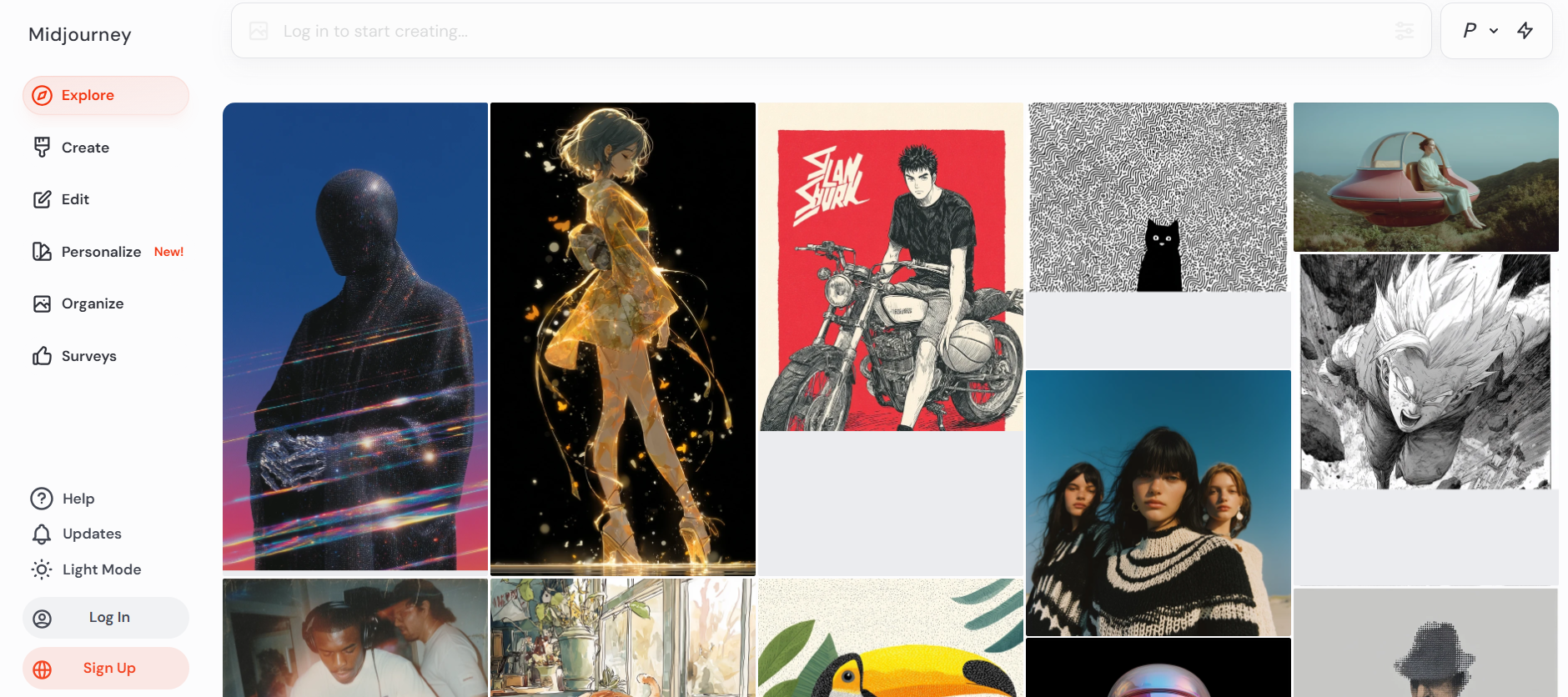
Midjourney’s Dashboard Midjourney generates high-quality, artistic images based on descriptive prompts you provide.
You enter a text description in their Discord-based interface, and the AI produces several visual interpretations.
The process is iterative; you can refine or upscale images through commands.
We’ve found Midjourney particularly useful for creative brainstorming and concept art, where varied and imaginative visuals are needed quickly.
It leans towards stylistic and surreal renderings, making it ideal when you want eye-catching, original designs rather than photorealistic images.
-
Leonardo AI
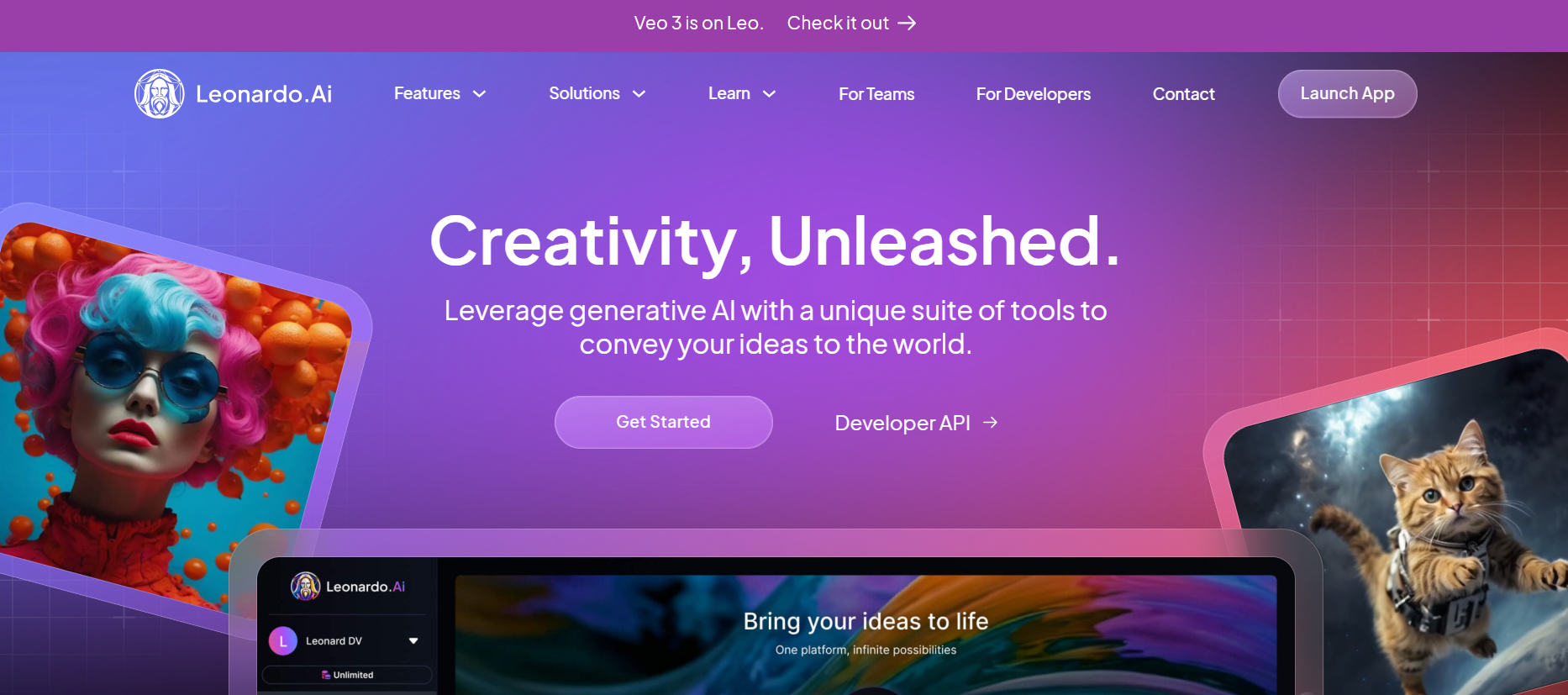
Leonardo AI’s Landing Page Leonardo AI offers a user-friendly interface for producing detailed digital art and illustrations.
It supports advanced customization like style transfer and image-to-image generation, allowing for more control over the final output.
From my experience, it’s a versatile tool for creating polished, refined images that fit professional branding or editorial needs.
It also offers features to blend multiple inputs, which helps when combining concepts or refining partial designs into cohesive visuals.
-
DALL·E 3 (OpenAI)

DALL·E 3’s Dashboard DALL·E 3 generates photorealistic or stylized images from text prompts using OpenAI’s advanced models.
It’s accessible via APIs and integrated platforms, supporting high detail and complex compositions.
We often use DALL·E 3 when projects require clear, clean visuals, such as product mockups or simple marketing graphics.
Its ability to understand nuanced instructions and combine multiple elements in a single image reduces the back-and-forth often required in traditional design workflows.
-
Adobe Firefly
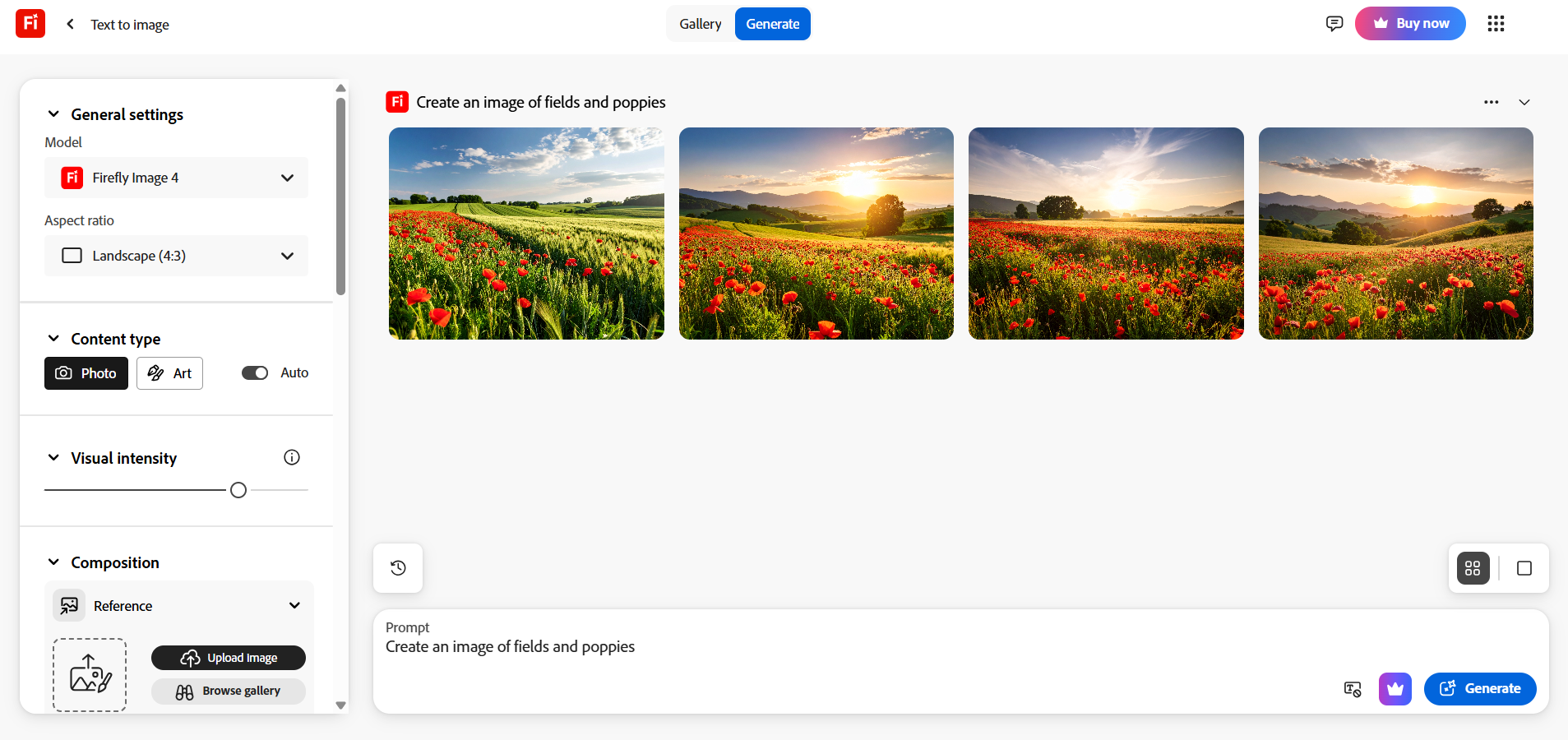
Adobe Firefly’s Dashboard Adobe Firefly integrates AI image generation directly into Adobe’s creative suite, making it convenient for users already familiar with Photoshop or Illustrator.
It produces editable, layered images that fit seamlessly into existing projects.
From my use, Firefly is best when you want AI-generated visuals that can be further refined using professional design tools, blending automation with manual precision.
-
NightCafe Studio

NightCafe’s Landing Page NightCafe Studio provides a straightforward platform for generating art using various AI models.
It supports multiple artistic styles and allows batch processing of images.
We’ve used NightCafe when needing quick iterations across different styles to find the right aesthetic direction.
While it’s less customizable than some other tools, it’s accessible and effective for rapid creative experimentation.
Top AI Video Creation or Editing Tools
AI video tools automate time-consuming editing tasks, enabling the fast production of engaging video content.
These platforms help streamline workflows by generating, cutting, or enhancing videos based on user input.
This is particularly useful for marketers, educators, and content creators who need video at scale.
-
Synthesia/Imagine.Art

Synthesia’s Dashboard Synthesia enables you to create videos featuring AI-generated human avatars that deliver your script.
You simply type in your text, choose an avatar and language, and the platform produces a video without the need for cameras or actors.
We’ve found it especially helpful for corporate training videos, product demos, and explainer content where quick turnaround and localization are important.
It streamlines filming logistics and supports multiple languages, making it useful for global teams.
-
Lumen5
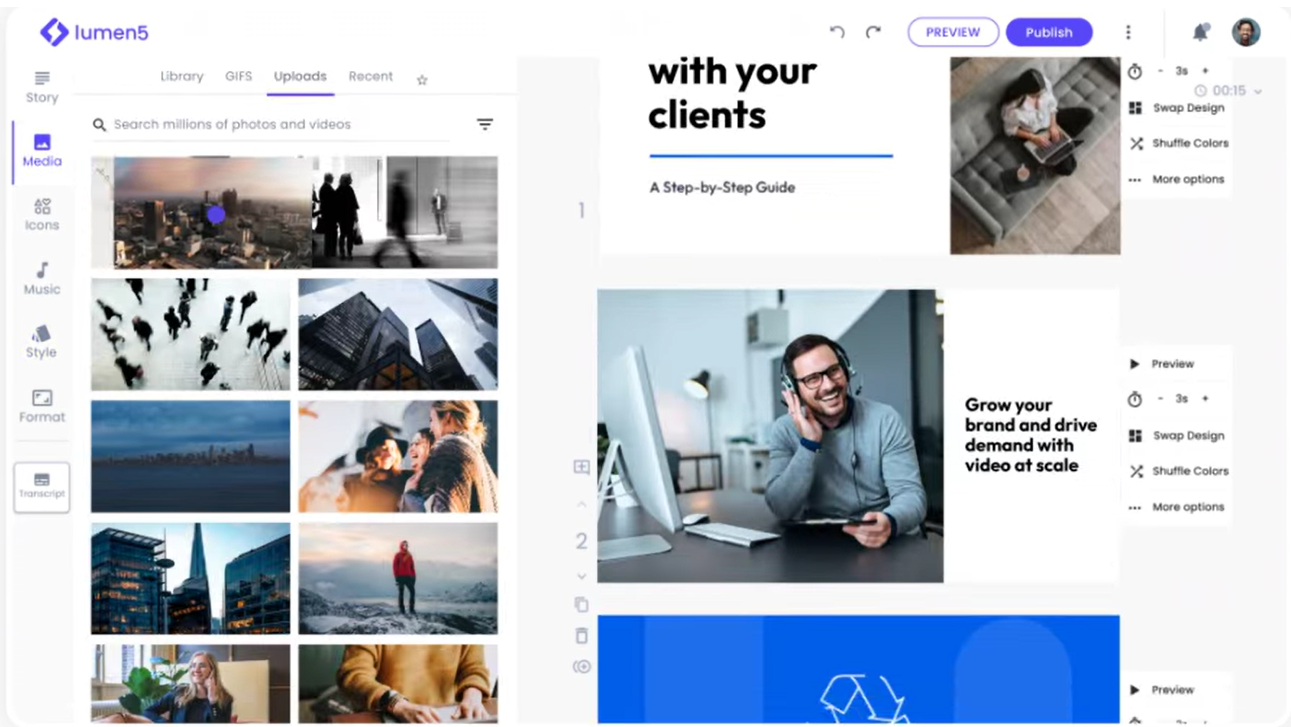
Lumen5’s Dashboard Lumen5 converts blog posts and articles into short, social media-ready videos.
You paste your text, and the AI matches key points with relevant visuals and music from its library.
From experience, it works well for repurposing written content into engaging video snippets without heavy manual editing.
It’s ideal when you want to quickly expand your content format for platforms like LinkedIn, Instagram, or TikTok.
-
InVideo AI
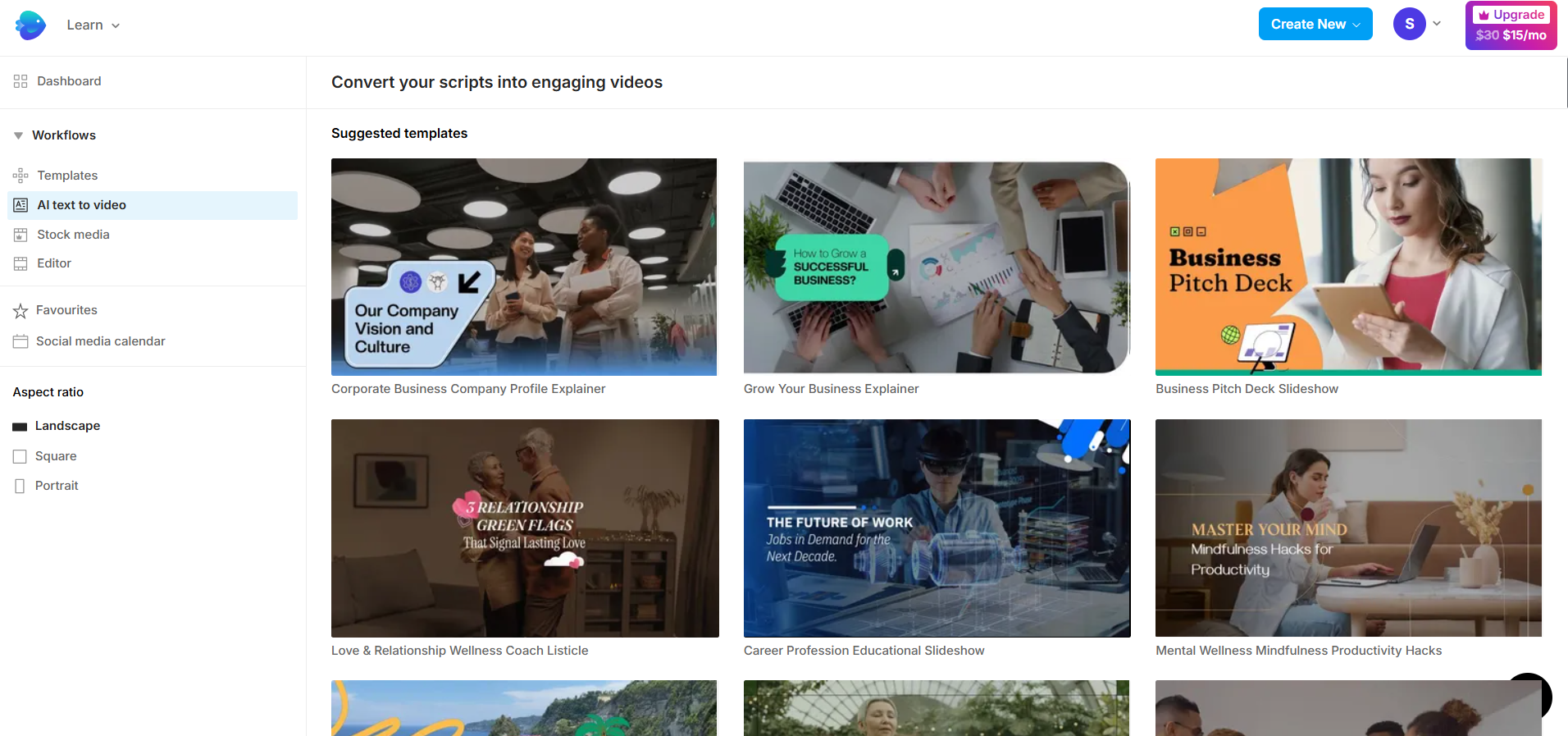
Invideo AI’s Dashboard InVideo AI focuses on transforming scripts and storyboards into polished videos with minimal effort.
Its AI suggests layouts, transitions, and stock footage to build a cohesive video.
We’ve used InVideo AI for marketing videos and presentations that require professional-looking output quickly, especially when combining voiceovers and on-screen text.
It strikes a balance between automation and manual controls, allowing for fine-tuning of details.
-
FlexClip
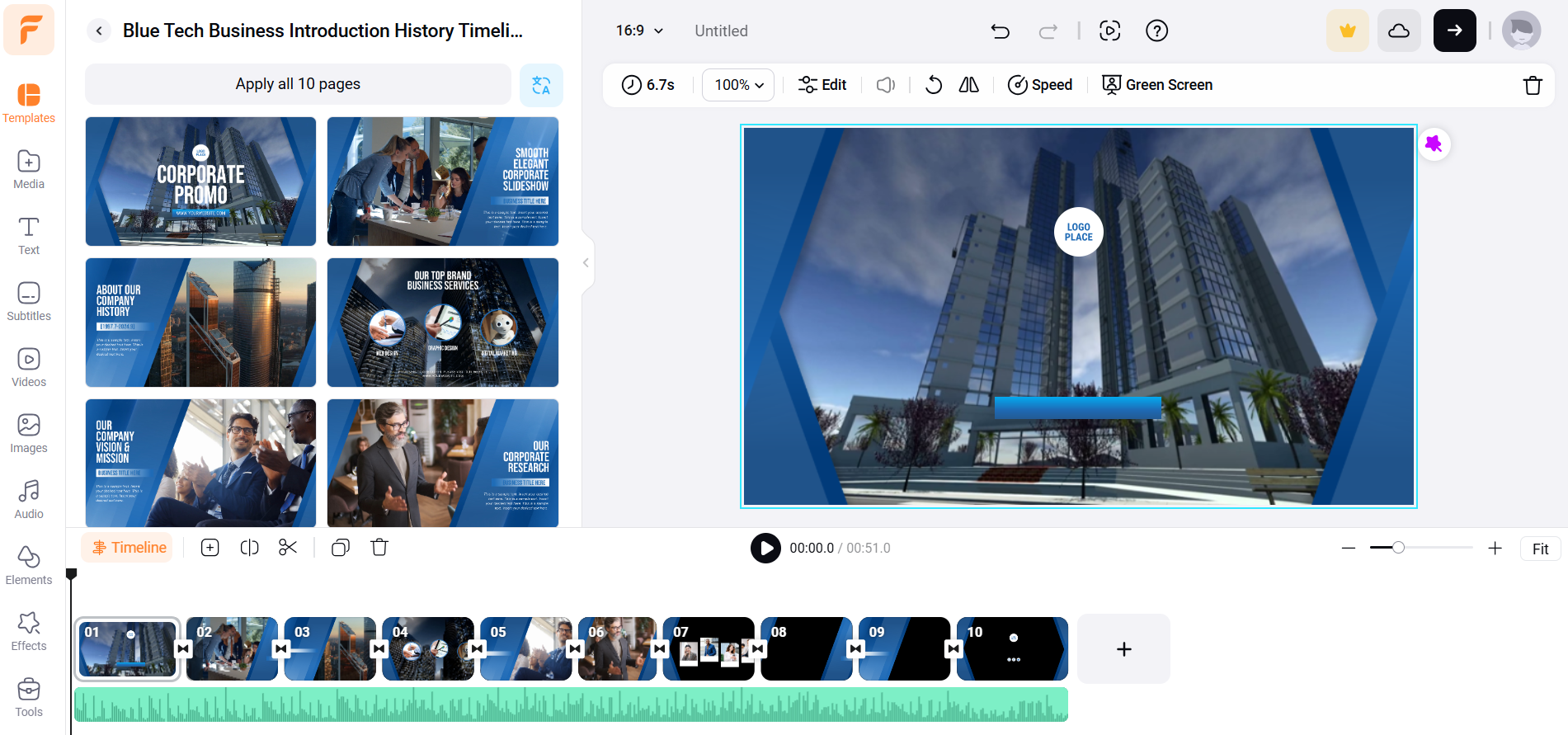
FlexClip’s Dashboard FlexClip provides simple tools for trimming, combining clips, adding text overlays, and incorporating music.
It includes AI-powered features like auto-captioning and quick template-based video creation.
In practice, we turn to FlexClip for straightforward projects that require fast edits without complicated software.
It’s particularly helpful for small businesses or solo creators needing clean, concise videos.
-
Clipchamp
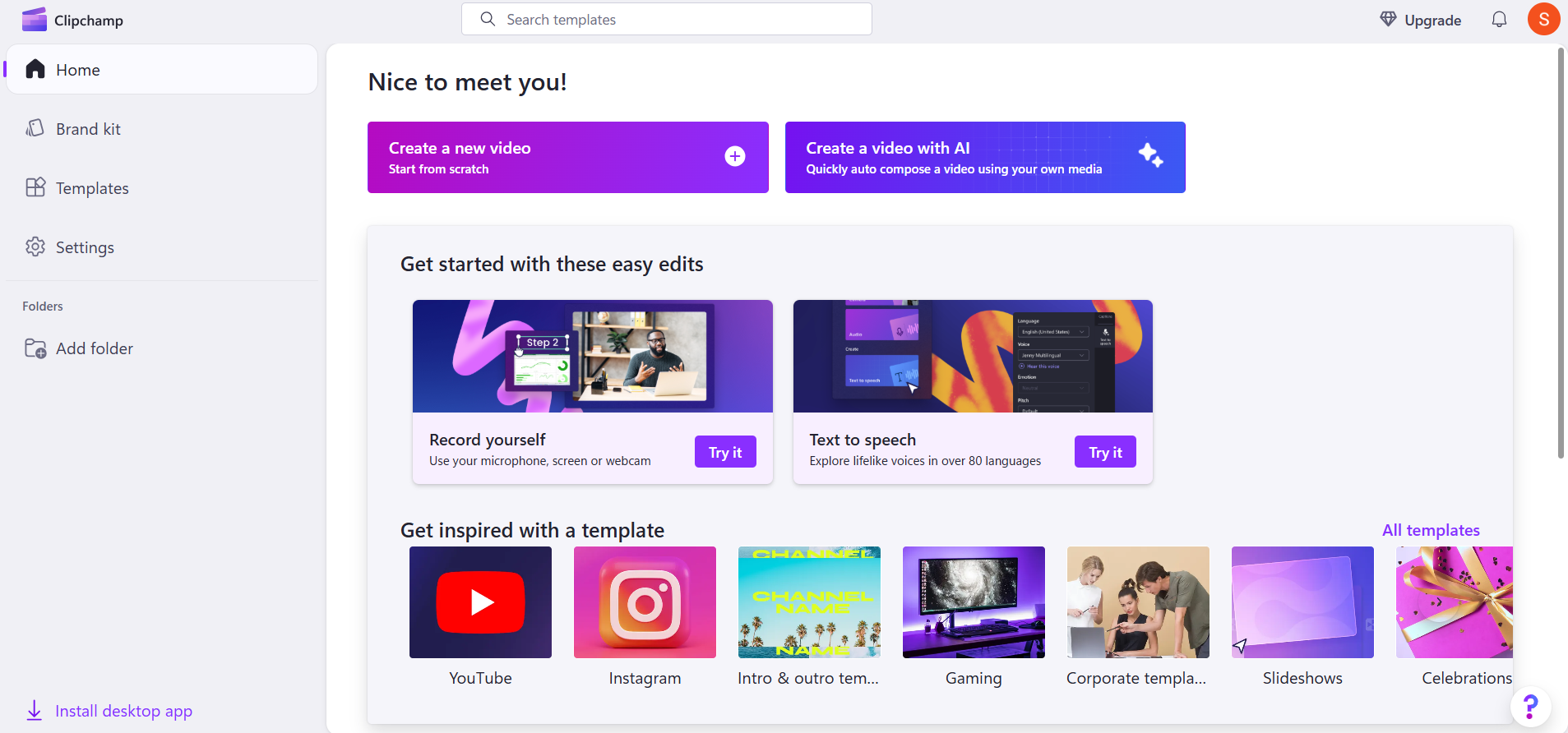
Clipchamp’s Dashboard Clipchamp integrates AI video editing with cloud-based collaboration.
It supports features like text-to-speech, auto-subtitles, and video compression.
Having used Clipchamp, we appreciate its ease for team projects and quick export options.
It’s suited for social media content, tutorials, and ads where quick iteration and sharing are priorities.
Top AI Tools for Branding and Design
These AI tools help streamline visual identity creation from logo design to brand kits, without needing in-depth design skills.
They’re particularly useful when launching a new brand, testing multiple visual directions, or producing quick assets for marketing.
-
Canva
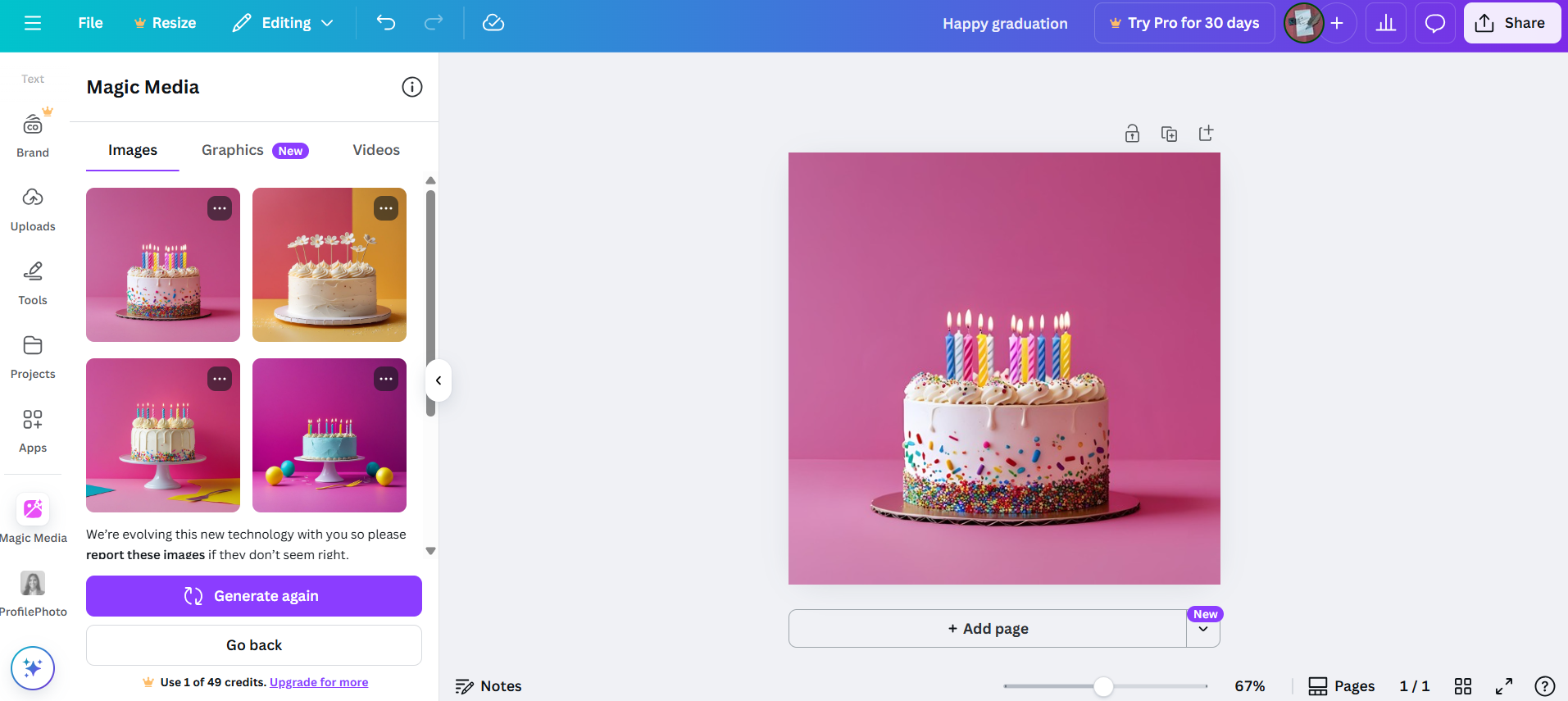
Canva’s Dashboard Canva now includes AI-powered features like Magic Design, Magic Write, and text-to-image, which speed up branding tasks.
You can input a few keywords or a business name, and Canva suggests logos, fonts, and color palettes to match.
It is used to build pitch decks, social media assets, and branded templates on tight timelines.
The “Brand Kit” feature makes it easier to maintain consistent fonts, colors, and logos across different projects, especially when managing multiple brands or clients.
-
Looka
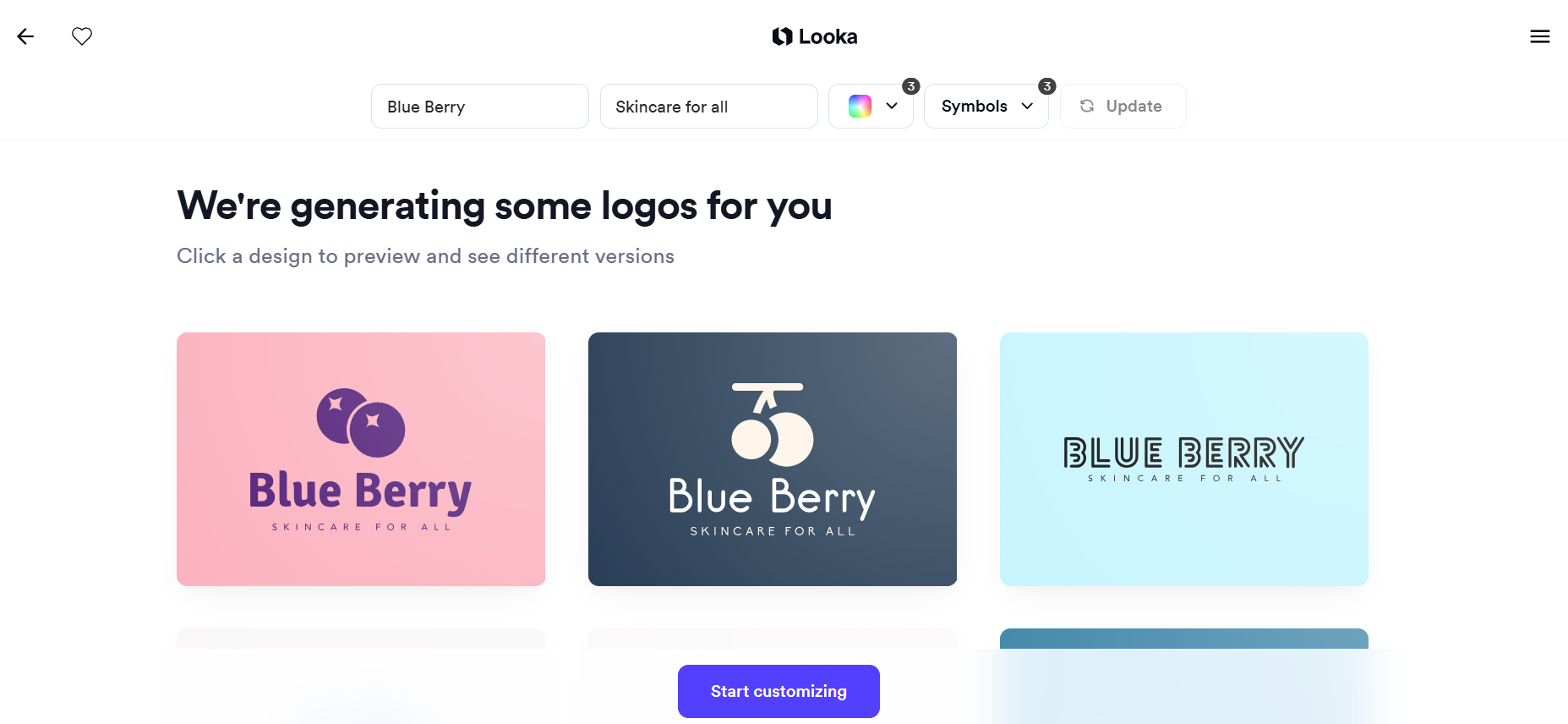
Looka’s Dashboard Looka creates logo designs and full brand kits from a few initial inputs, such as your company name, industry, and preferred style.
Once you enter the details, the tool generates dozens of logo variations and automatically creates a visual identity kit, including fonts, colors, and mockups.
You can use it when clients need a fast branding starter pack.
It doesn’t replace a custom brand strategy, but it works well for early-stage projects or MVPs.
-
Brandmark
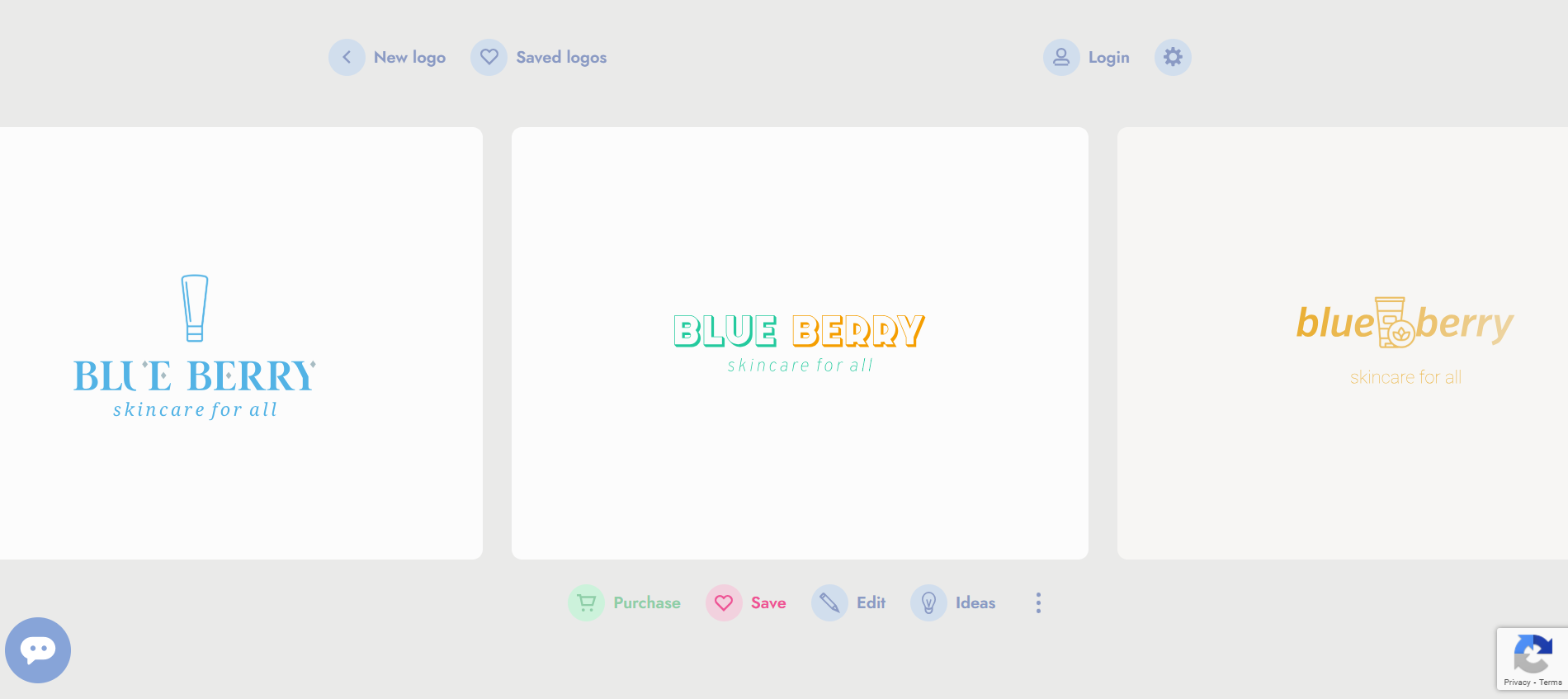
Brandmark’s Dashboard Brandmark offers instant logo and brand system creation through AI.
You enter your company name and a few descriptive keywords, and the tool outputs logos, icons, and typography suggestions.
What we found helpful is the ability to preview how logos will look across various formats social media, packaging, and business cards, before downloading.
It’s a lightweight tool, best for those who want a quick visual identity without hiring a designer.
-
Design.ai
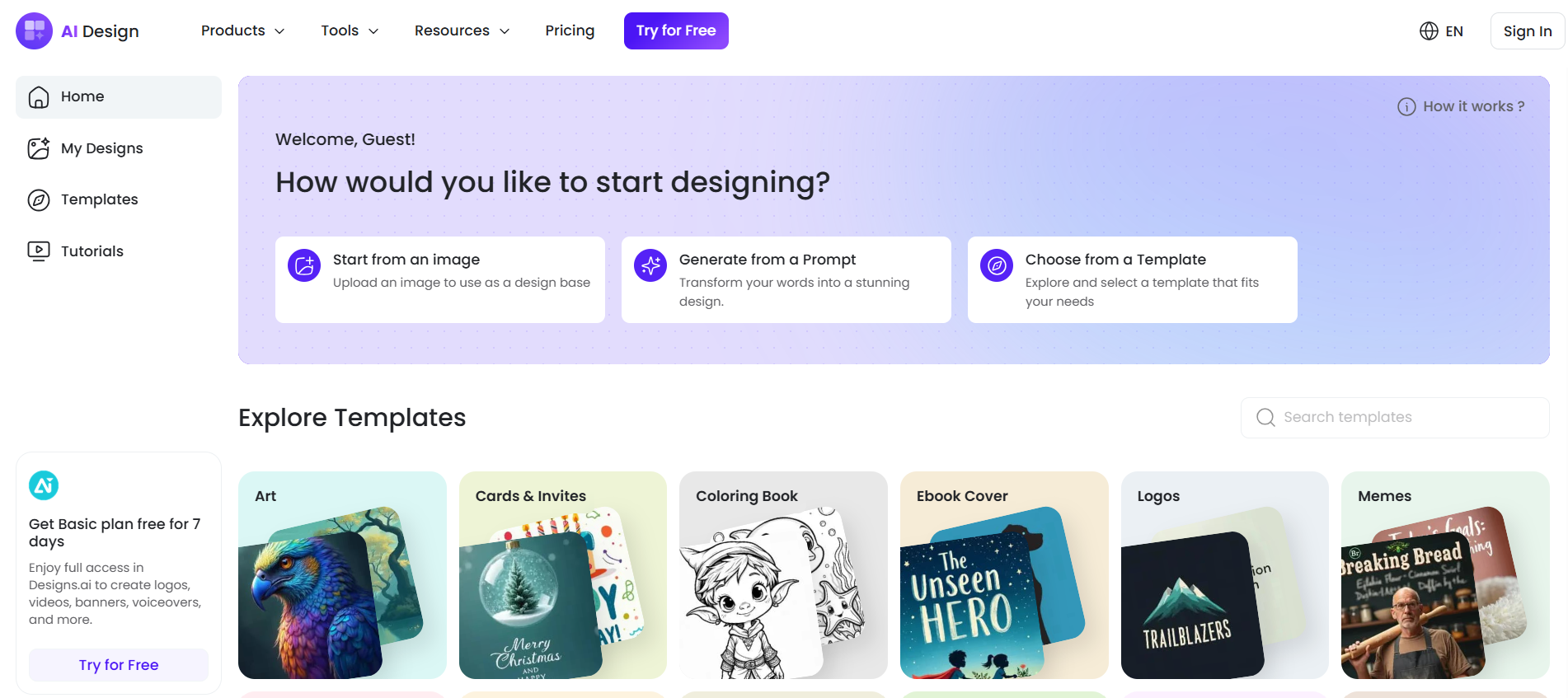
Design.ai’s Dashboard Designs.ai is a suite that covers logo creation, brand visuals, videos, and mockups.
It utilizes AI to generate branding assets tailored to business details and a desired tone.
You can use it to generate quick, uniform assets, such as business cards, social media headers, and promotional banners.
It’s most effective when you need a whole bundle of visual materials with minimal manual design input, especially for small businesses or side projects.
AI Content Tools for Social Media Management
Managing social media requires more than just posting consistently.
From crafting compelling captions to scheduling content across multiple platforms and tracking what performs best, AI has become an essential part of the process.
These tools now help brands automate the heavy lifting, ensuring content remains timely, engaging, and aligned with audience behavior.
AI can assist in generating tailored post captions, repurposing blog content into social formats, suggesting optimal posting times, and providing in-depth performance analytics.
-
All-In-One AI Social Management With Social Champ
Social Champ brings all of these AI capabilities under one roof.
As a complete platform for social media management, it helps brands automate, optimize, and elevate their content strategy.
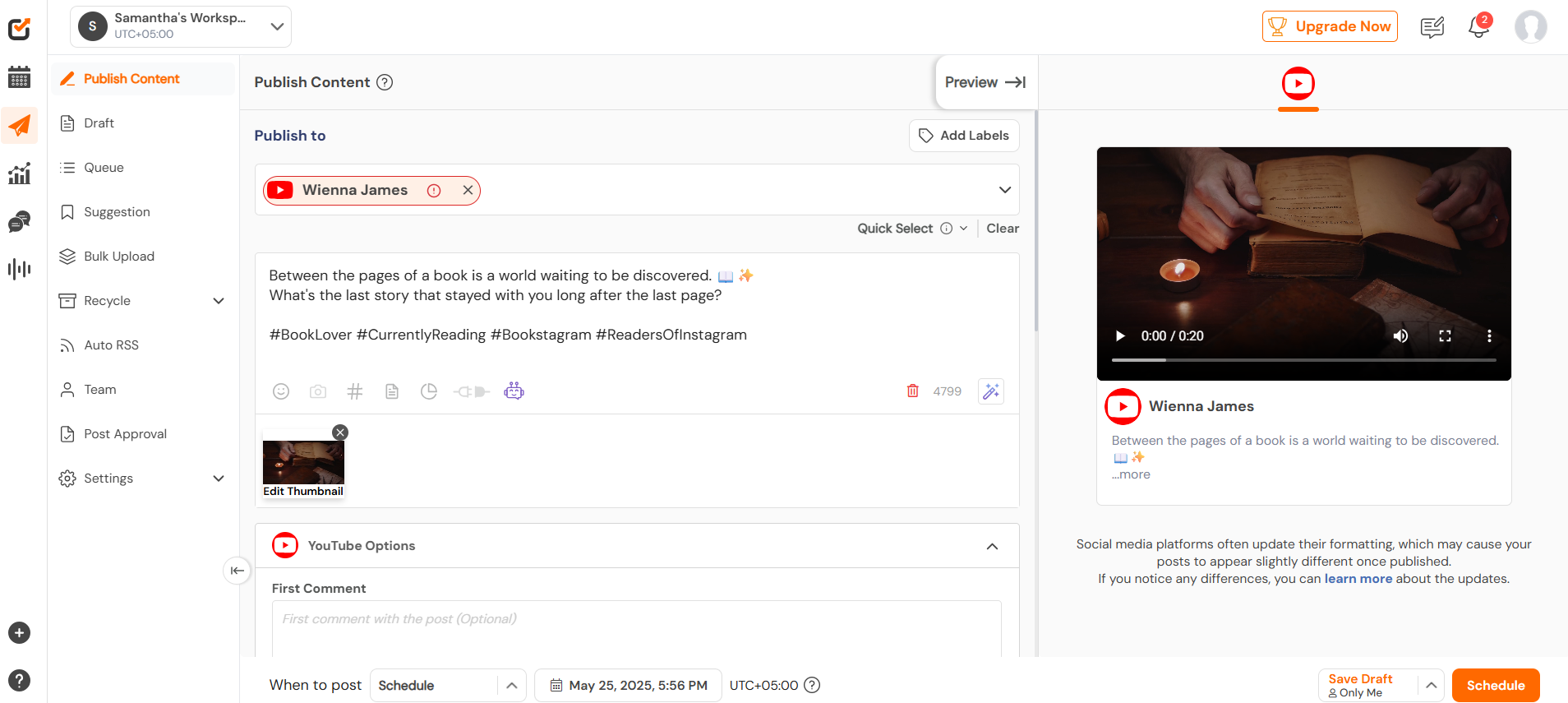
Social Champ’s Dashboard Key features include:
- AI-Powered Caption Generator – Instantly generate platform-specific copy from a few keywords or post ideas.

Social Champ’s AI Content Wizard - AI Imaginator – Effortlessly create eye-catching visuals using AI, perfect for enhancing your social media content without needing a designer.
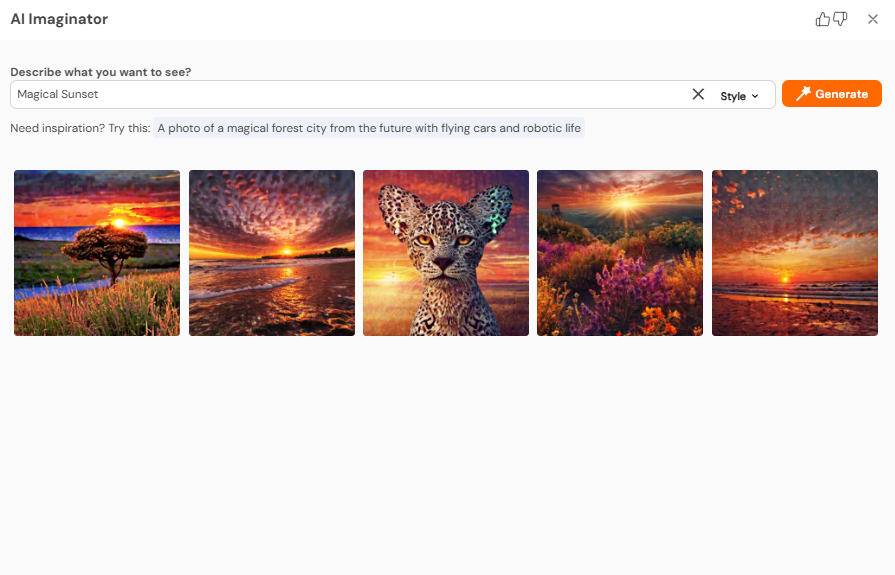
Social Champ’s AI Imaginator - Smart Scheduler – Auto-publish posts at peak engagement times across Facebook, LinkedIn, Instagram, Twitter (X), Pinterest, and more.
- Content Recycling – Reuse your top-performing posts to maintain visibility without duplicating effort.
- Real-Time Analytics – Track impressions, clicks, and engagement to see what’s working.
- Visual Content Support – Easily integrate media, hashtags, and emojis directly from the dashboard.
For teams that want to stay consistent, data-driven, and ahead of trends, Social Champ makes managing social content smarter and far more scalable.
- AI-Powered Caption Generator – Instantly generate platform-specific copy from a few keywords or post ideas.
-
Hootsuite
Hootsuite is a leading social media management platform that incorporates AI to streamline content workflows.
Its AI-powered tool, OwlyWriter AI, assists with writing captions, repurposing existing content, and generating new post ideas based on engagement history.
Combined with features for scheduling, monitoring, team collaboration, and analytics, Hootsuite enables brands to manage their social presence efficiently while keeping content relevant and data-informed.
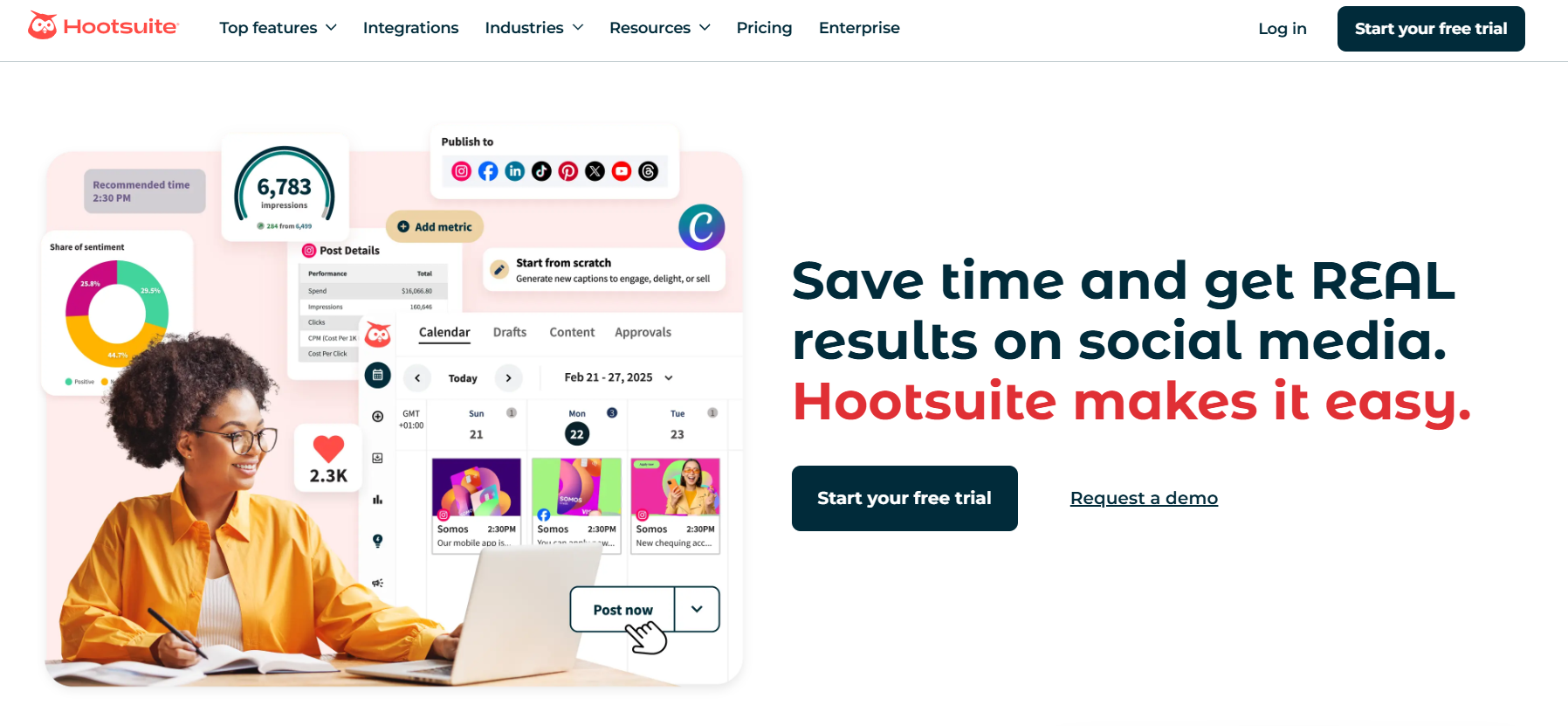
Hootsuite’s Landing Page -
Buffer
Buffer offers a complete suite for social media planning, publishing, and analysis, with AI features built into its content creation process.
Its AI Assistant helps craft channel-specific captions that align with your tone and goals.
Users can schedule posts, track engagement metrics, and collaborate with team members, all while leveraging AI suggestions to maintain consistency and improve performance over time.
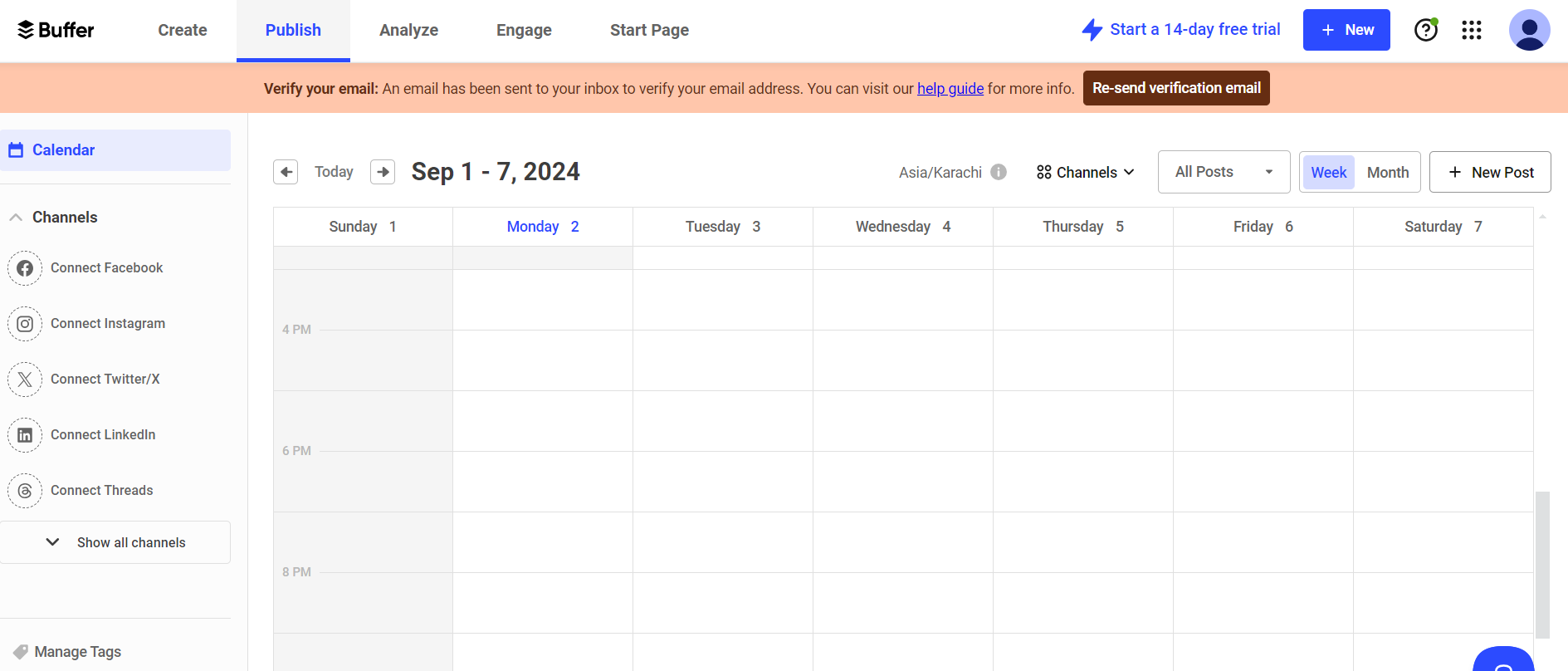
Buffer’s Dashboard -
Later
Later focuses on visual social media platforms like Instagram, Pinterest, and TikTok, offering both scheduling capabilities and AI enhancements.
Its AI Caption Writer helps generate engaging descriptions tailored to each post.
With tools for drag-and-drop scheduling, link-in-bio customization, hashtag suggestions, and performance analytics, Later enables brands to manage their visual content strategy while using AI to optimize engagement and timing.
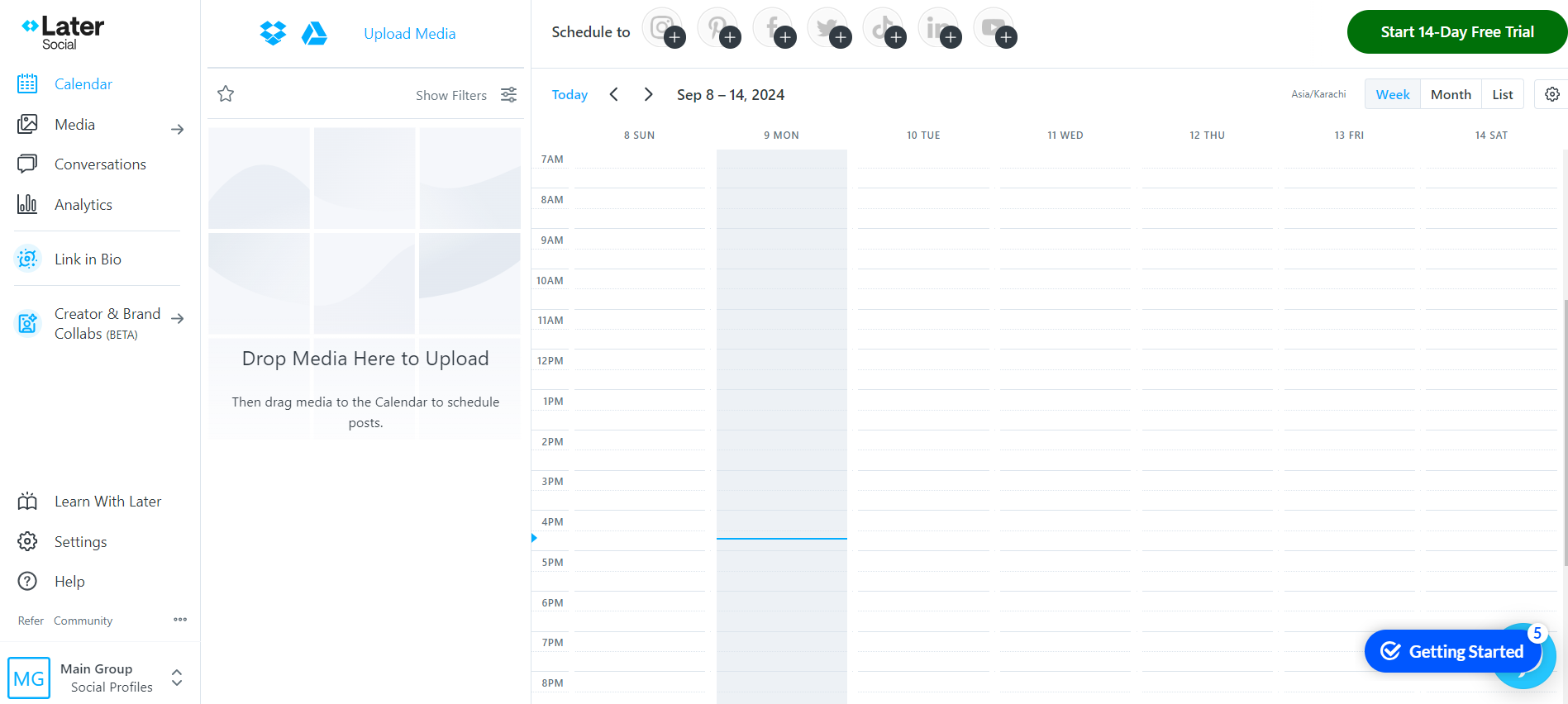
Later’s Dashboard
CTA
Your Content, Supercharged by AI!
Create, repurpose, and automate content effortlessly with Social Champ’s AI Suite. Try for free today!
How to Choose the Right AI Content Creation Tools for Your Needs
With numerous AI content creation tools available, selecting the right one can be overwhelming.
The best way to decide is by focusing on your specific use case, the type of content you produce, the size of your team, and the tools you already use.
AI should streamline your workflow, not complicate it.
Here’s a quick framework to guide your decision:
Start With Your Primary Content Needs
The first step is to identify what kind of content you create the most.
If your focus is on writing, especially long-form articles, rewriting, or SEO optimization, look for AI tools that specialize in natural language generation and keyword integration.
For content that relies heavily on visuals, such as branding or video, prioritize AI tools designed to assist with image creation, graphic design, or video editing.
If social media is your primary channel, select tools that include features for post scheduling, content repurposing, and analytics to help manage and measure your social presence efficiently.
Consider Team Size & Collaboration
Your team size greatly influences the type of AI tool you need.
Solo creators often prefer lightweight, budget-friendly tools that deliver quick results without a steep learning curve.
Small teams benefit from platforms that support collaboration, offering shared content libraries and simultaneous editing capabilities.
Larger teams and agencies should look for tools with advanced user permission controls, comprehensive asset management, and seamless integrations to effectively coordinate workflows across departments.
Check Integration and Workflow Fit
Integration capabilities are crucial to ensure the AI tool seamlessly integrates into your existing content production process.
Confirm that the tool can connect with your CMS, cloud storage, or social media management platforms.
Additionally, check whether it supports exporting content and assets in formats compatible with your team’s software, which helps maintain consistency and avoids bottlenecks.
Match the Tool to Your Budget
Budget considerations often shape the selection process.
Free plans or trials are ideal for testing a tool’s basic functionality and determining if it suits your workflow.
Paid plans typically offer enhanced features, including higher-quality content generation, expanded export options, and team collaboration tools.
Align your budget with the features you truly need to maximize ROI.
| Use Case | Recommended Tool Type | Best For | Integration Level | Budget Fit |
| Blog & SEO Writing | SurferSEO, Jasper, ChatGPT | Long-form writers, SEO teams | Medium–High | Mid to High |
| Social Media Scheduling & Content | Social Champ, Copy.ai, Wordtune | Social managers, content creators | High | Low to Mid |
| Visual & Design Creation | Canva, Adobe Firefly, Leonardo AI | Designers, marketers | Medium | Flexible |
| Video Content & AI Editing | Synthesia, Lumen5, InVideo AI | Training, marketing, and repurposing teams | Medium | Mid to High |
| Branding & Logo Design | Looka, Brandmark, Designs.ai | Startups, small businesses | Low | Low to Mid |
Future Trends in AI Content Creation: What to Watch in 2025 and Beyond
Best AI content creation tools are evolving faster than ever, pushing boundaries beyond simple text generation.
Several key trends are shaping the future landscape of digital content:
Multi-Modal Content Generation
AI is increasingly capable of creating integrated content, combining text, images, audio, and video seamlessly.
This means future tools will produce richer, more engaging multimedia content from a single prompt.
AI-Powered SEO Audits and Strategy
Beyond content creation, AI will offer advanced SEO insights, identifying content gaps, optimizing keyword targeting, and monitoring ranking factors with minimal human intervention.
Hyper-Personalization at Scale
Leveraging user data, AI will craft deeply personalized content tailored to individual preferences, behaviors, and demographics, boosting engagement and conversion like never before.
Ethical AI Use and Transparency
As AI adoption grows, so will scrutiny of ethical considerations.
Content creators will need tools that ensure originality, fairness, and transparency, avoiding plagiarism and bias while respecting data privacy.
These advancements promise to make content creation more efficient, impactful, and responsible, offering brands new ways to connect with audiences while navigating emerging challenges thoughtfully.
CTA
Social Media Management That Just Clicks!
From bulk scheduling to AI captions, Social Champ gives you the power to scale without the stress. Sign up for free today.
Conclusion
AI content creation tools are transforming how businesses and creators produce, optimize, and distribute content at scale.
As technology advances, these tools will continue to evolve, offering smarter, more personalized, and efficient ways to meet the growing demands for content.
Choosing the right AI content creation tools tailored to your specific needs is essential for staying competitive and maximizing productivity.
